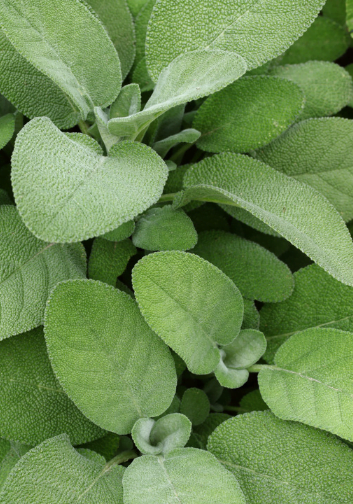Native to Europe, parsley is a biennial plant that is generally grown as an annual culinary herb. Growing in clumps of lacy foliage about a foot high, parsley has triangular dark green leaves that make for a good garnish or an aromatic addition to recipes. Best planted in the spring, most varieties of parsley grow fairly slowly, establishing maturity between 70 to 90 days after planting.

| Common Name | Sage, common sage, culinary sage, garden sage |
| Botanical Name | Salvia officinalis |
| Family | Lamiaceae |
| Plant Type | Herb, perennial |
| Size | 2–2.5 ft. tall, 2–3 ft. wide |
| Sun Exposure | Full sun |
| Soil Type | Loamy, sandy, well-drained |
| Soil pH | Acidic, neutral (6–7) |
| Bloom Time | Summer |
| Hardiness Zones | 4–10 (USDA) |
| Native Area | Mediterranean |

When to Plant?
This will be determined by your planting zone. There is a final frost date for each area. As a result, you can plan your gardening activities around this date. Check our Frost Dates Across North America: First & Last Frost Dates Chart. However, the date will not be the same for every plant.
How to Plant
Сontainers for growing sage should be at least 0.25 gallons in volume.
Plant sage after the ground temperature reaches 65°F, about 1- 2 weeks before you have the last frost.
Sage seeds will take about three weeks to germinate, and then you can transplant seedlings to your prepared, well-draining soil.
When 3-4 leaves have formed on the seedlings, dive the seedlings into separate 0.5-gallon plastic or clay pots.

Sage is a hardy perennial with pretty, grayish-green leaves. Sage is easy to grow and can be used to flavor all types of meat and bean dishes. Sage blossoms are great to toss into salads. Companions: tomatoes, strawberries, carrots, and cabbage.
How to Cultivate
Soil – Any well-drained, sandy, loamy soil enriched with compost is suitable.
Sun – Full sun.
Spacing – 8 – 12″
Water – Sage is a fairly drought-tolerant herb.
Do not overwater.
Wait until the soil is dry to give it a thorough watering.
Fertilizer – Drench plants with water-soluble organic plant food one month after setting them out.
Frost tolerant – Hardy only to about 15°F.
How to Harvest
Harvest sage lightly during the first year to ensure the best results for the second year.
Gather sprigs as needed in the kitchen.
Cut the sage stems, harvesting no more than half of the plant.
Harvest sage leaves in the morning, once the dew has dried.
Gather stems for drying from spring to fall.
Pinch off leaves or snip off small sprigs from the plant.
Stop harvesting in the fall so the plant can prepare for winter.
Sage’s flavor is best when fresh, but it can be stored frozen or dried.
Hang sprigs in a shady, well-ventilated area. Allow them to air dry, waiting until the leaves crumble.
Sage keeps its flavor better if stored in the freezer.
Freeze leaves or stalks on a tray, then move the leaves into a zippered bag or container.
Hydroponics
Germination: Soak sage seeds in water for 24 hours before sowing. Place the soaked seeds in a small pot filled with a germination medium like rockwool or coco coir. Water the seeds regularly and keep the pot in a warm and well-lit area. The seeds should germinate in about 1-2 weeks.
pH range: The pH range for hydroponic sage should be between 5.5-6.5. Maintaining the correct pH level is important for the plants to absorb the necessary nutrients.
EC: The electrical conductivity (EC) level should be maintained at around 1.5-2.5 mS/cm for hydroponic sage. This helps to ensure that the plants receive the right amount of nutrients.
PPM: The parts per million (PPM) for hydroponic sage should be around 900-1600 ppm. This measures the concentration of nutrients in the water solution.
Humidity: The humidity level should be maintained at around 40-60% for sage to grow properly. This can be achieved by using a humidifier or by placing a tray of water near the plants.
Light hours: Sage requires about 12-14 hours of light per day for optimal growth. You can use artificial lights like LED grow lights to provide the necessary light if natural light is not available.
Temperature air: The air temperature should be maintained at around 20-24°C (68-75°F) during the day and around 16-18°C (60-65°F) at night for sage to grow well.
Temperature water: The water temperature should be maintained at around 20-22°C (68-72°F) for hydroponic sage. This helps to ensure that the plants absorb the necessary nutrients.
Overall, growing sage hydroponically can be a rewarding experience, and following these guidelines can help you grow healthy and vibrant plants.
Common Pests and Diseases
Mint rust (Puccinia menthae)
Symptoms: Small, dusty, bright orange, yellow or brown pustules on undersides of leaves; new shoots may be pale and distorted; large areas of leaf tissue die and leaves may drop from plant
Cause: Fungus
Management
Infected plants and rhizomes should be removed to prevent spread; heat treatment of roots may help to control the disease; roots should be immersed in hot water at 44°C (111°F) for 10 minutes, cooled using cool water and then planted as usual



